Reducing the ecological impact of cane toads
Reducing the ecological impact of cane toads on our Australian biodiversity is the main reason we want to control cane toads. How do we achieve that impact reduction?
Well, everybody who has set out to deal with the toad problem seems to
have focused on how to get rid of toads. The trouble with that approach is that it's almost impossible to achieve the result we want, especially in tropical Australia (see our pages about controlling cane toads).
But there is another possible approach that has been ignored. Perhaps we can reduce the ecological impact of toads not by changing toad numbers, but by changing the ability of native species to deal with toads?
We don't want to sound like we've given up on the attempt to control cane toads. We haven't. In other pages on this website, we explain TEAM BUFO’s new methods for controlling cane toads. These ideas work well, and our tadpole-trapping methods are already being used very widely by members of the general public. Our new genetic methods will be even more powerful. To be optimistic, let’s suppose that we DO manage to find a way to kill 95% of the cane toads in the population. Would that be enough to stop the toad invasion, or to save the native fauna in areas that the toads invade? Sadly, no.
A difficult problem
The first problem is that those large fast-dispersing toads at the front will just keep on moving - so even if 95% of them are killed, the other 5% will keep moving forward. The front-line toads have been modified by evolutionary processes into incredible dispersal machines – no matter what happens, they just keep moving (see our website page on TOAD EVOLUTION). Thus, the toads will continue to sweep westwards, even if we greatly reduce their numbers.
And there's another problem. Even if the numbers of toads are low, the few that are left will still have a major impact. The reason is that unlike frogs, toads are really obvious - they like to sit out in the open, in places where they are easy for predators to find. Perhaps they are "advertising" their poisonous nature - which may work in South America (where predators share a long evolutionary history with toads), but doesn't work in Australia where the local predators just think they have found a particularly large, particularly stupid edible frog.
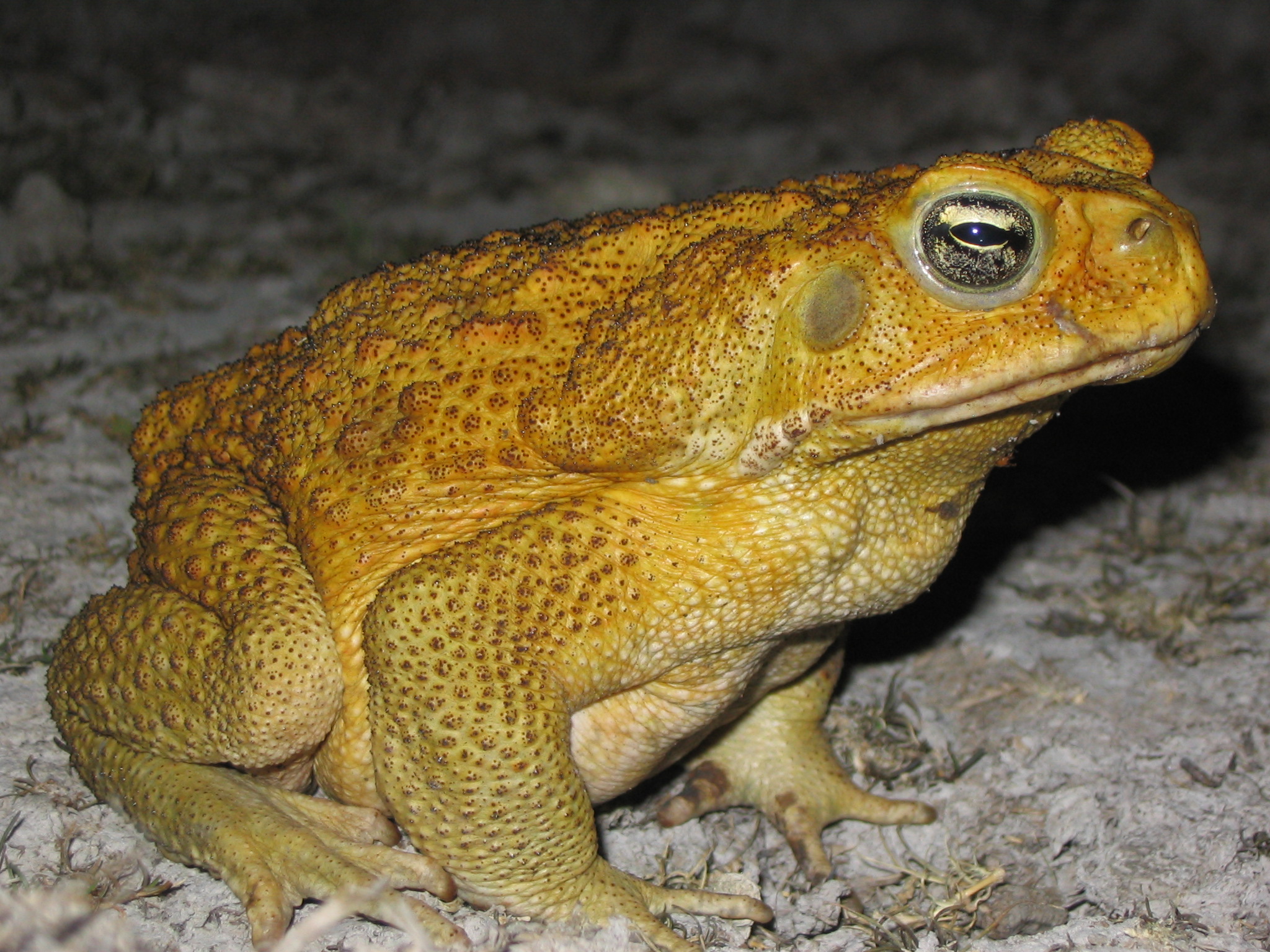
Unlike native frogs, cane toads like to sit out in the open, and are easy for predators to find. Photo by Ben Phillips.
So even a few big toads in an area are likely to spell almost certain death for animals like goannas, quolls and king brown snakes - predators that move about over large areas, and are very good at locating prey.
A new solution to that problem
Is there anything we can do to save those predators, or do we just have to sit back while thousands of native predators are killed when they encounter large toads at the invasion front? Well, there IS a possible solution. It was controversial when Rick first suggested it, but most community groups and wildlife management agencies are now convinced that it is a good idea. At first sight, it sounds crazy – but here goes.
We could introduce SMALL cane toads in advance of the main toad invasion, so that the predator's first encounter is with a tiny toad not a big one. That would give predators a chance to learn that toads are poisonous - and so, avoid toads from then on.
This may sound like it requires a bit more intelligence than we expect from goannas and so forth, but TEAM BUFO’s work has shown remarkably fast learning in many native species. For example, this is true for many fishes (from tiny gudgeons to large barramundi), frogs (including just about every species we've tested) and marsupials (planigales and dunnarts). If the first toad they meet is small, the predator gets sick but recovers, and avoids toads afterwards - so that by dumping small toads in advance of the main invasion front, we can give the native predators a better chance to survive.
We wouldn't dump small toads everywhere across the landscape, of course. The idea is to create small pockets of resistance (with "toad-smart" predators), so that after the main toad front arrives there are still some places where predators survive in reasonable numbers. Those pockets of "toad-smart" animals can eventually recolonise the landscape.
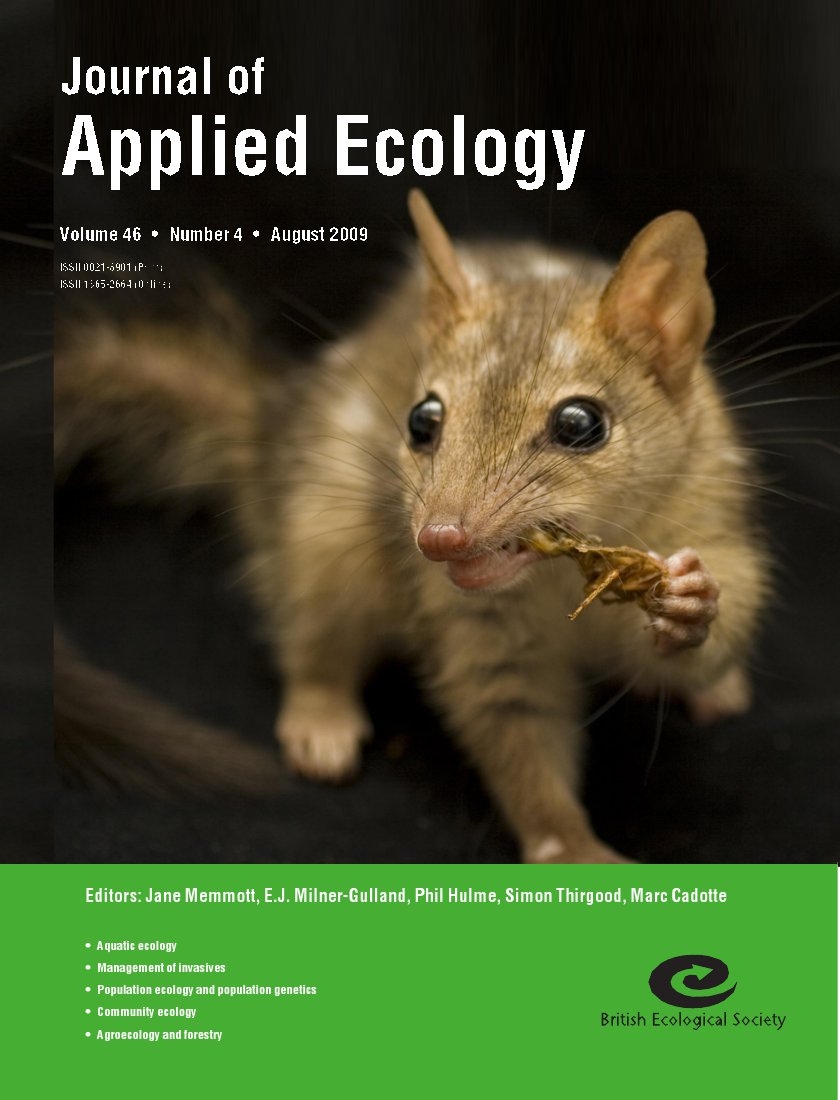
The best way to save predators like these
northern quolls may be to teach them to avoid toads - by
exposing them to small toads BEFORE the main invasion front arrives. Our scientific paper reporting success in this method was published in one of the top journals.
Some people are worried by the idea of releasing small cane toads in advance of the main front, even if the release point is only a few kilometres from the current front, in an area that is certain to be invaded by toads within a few months. We understand this reaction - but if we really want to stop our native predators being fatally poisoned as the toads sweep across the landscape, releasing small "teacher toads" is the only way to do it.
Our first test of the teacher toad” idea was been with quolls, the marsupial predators that risk being fatally poisoned when toads invade. Stephanie O’Donnell and Jonno Webb showed that quolls raised at the Territory Wildlife Park rapidly learnt to leave toads alone if we added a nausea-inducing chemical to the toads we offered. Encouragingly, those toad-trained quolls survived much better than their untrained brothers and sisters after we released them into the wild – despite the presence of toads. Stephanie won a major international prize for her paper about the study.
In follow-up work in Kakadu National Park (jointly
with park authorities), Taegan Cremona found that the trained quolls survive
for a long time after they are released – long enough to breed. This is really
exciting – it’s the first practical success in enabling Australian predators to
deal with cane toads. But the bad news from that study, and from follow-up work by Chris Jolly and Ben Phillips, was that most of the surviving quolls were killed and eaten by dingos and wild dogs. To conserve quolls, we will need to deal with that predator issue, as well as with the dangers posed by cane toads.
We received funding from the Australian Research Council and the Australian Government’s “Caring for our Country” initiative for this research program.
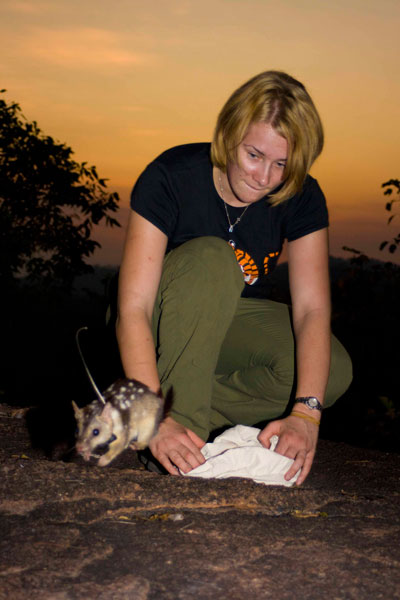
Stephanie
O’Donnell’s project involved training quolls not to eat toads, then releasing
the quolls and radio-tracking them to see if trained animals had better
survival. They did! Photo by Jonno Webb.
We then expanded Steph’s work on predator-training to some of the other species that are vulnerable to toads.
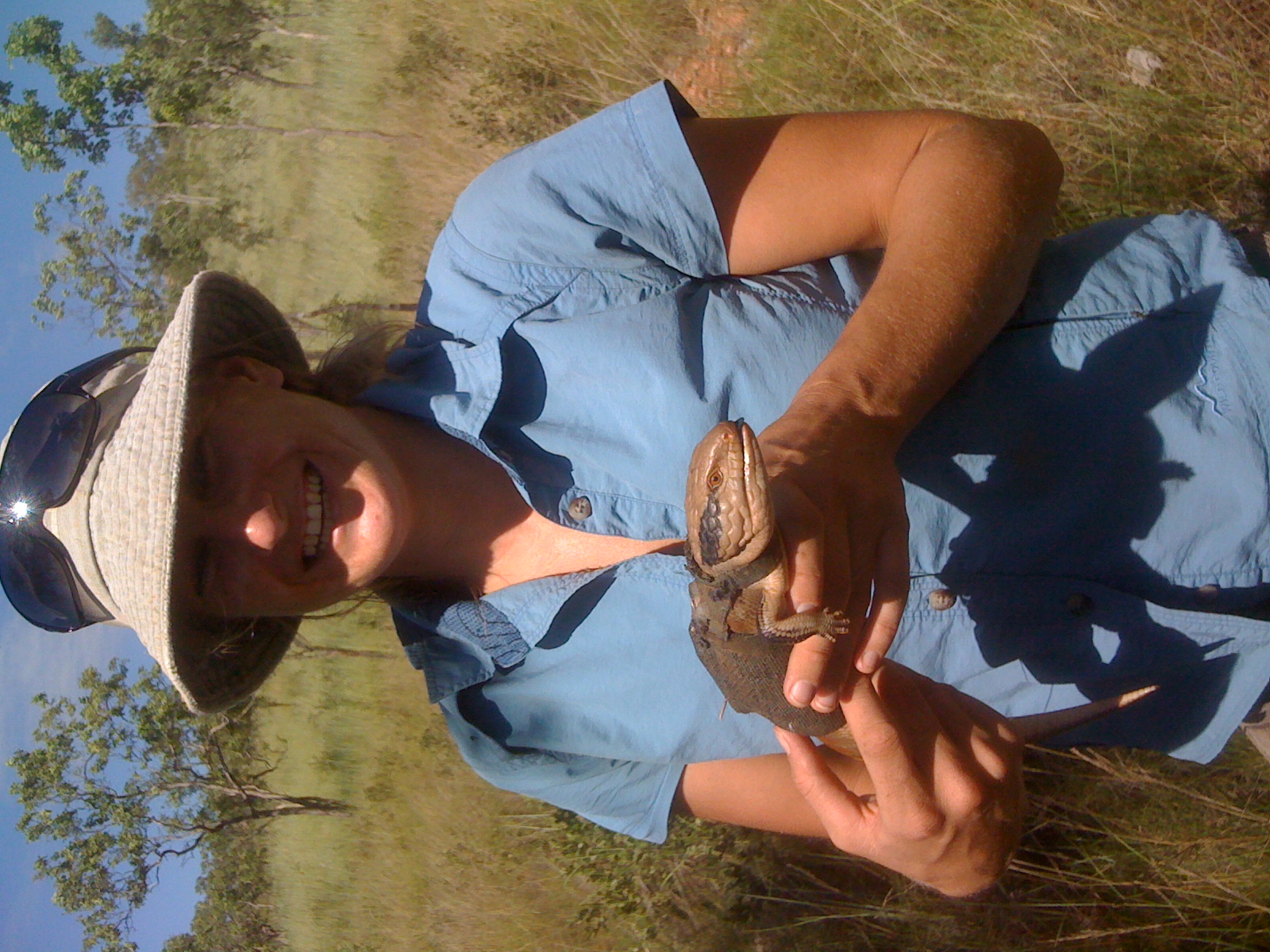
Sam
Price-Rees with one of the bluetongue lizards she radio-tracked. Photo by Rick Shine.
Our main focus has been on lizards. Sam Price-Rees followed blue tongue skinks around in the Kununurra area, using radio-transmitters to keep in touch with her animals. When edible-sized toads arrived at her study site, Sam trained half of her lizards to avoid toads, then re-released them. The trained lizards were much more likely to survive than the untrained ones, suggesting that taste-aversion learning can save reptiles as well as quolls.
The next challenge was to apply this idea to much larger lizards - the mighty goannas. Jai Thomas showed that these giant lizards can learn to avoid toads; and Georgia Ward-Fear showed that this education helped goannas survive when the toads arrived. Georgia did this work in collaboration with the Balanggarra Rangers and the Western Australian Department of Parks and Wildlife, in the Kimberley region. At a remote floodplain soon to be invaded by toads, she taught free-ranging goannas (monitor lizards) that cane toads are poisonous, by offering them small toads that were big enough to make them feel sick but not big enough not to kill them. It worked! 18 months later, after the toad invasion swept through, only one of 31 untrained lizards was still alive - but more than half of the trained lizards had survived.
The offspring of those trained adult lizards will grow up in a world with small toads around, because the toads have started breeding in the floodplain now. That gives the baby goannas a chance to learn that toads are poisonous, rather than being killed when they meet their first giant toad. So a single conservation intervention may be all that is needed; we don't need to keep training lizards year after year.
And in 2024, we released the results of two big field projects where we worked with other Indigenous groups and with government authorities in Western Australia to train goannas and freshwater crocodiles not to eat toads. We released over 200,000 baby toads - and the results were astounding. Goanna populations persisted in our "teacher toad" release areas, but plummeted in nearby "control" sites. Exactly the same thing happened with crocodiles. It works!
You can find out more about Georgia’s work on our “canetoadcoalition” website.
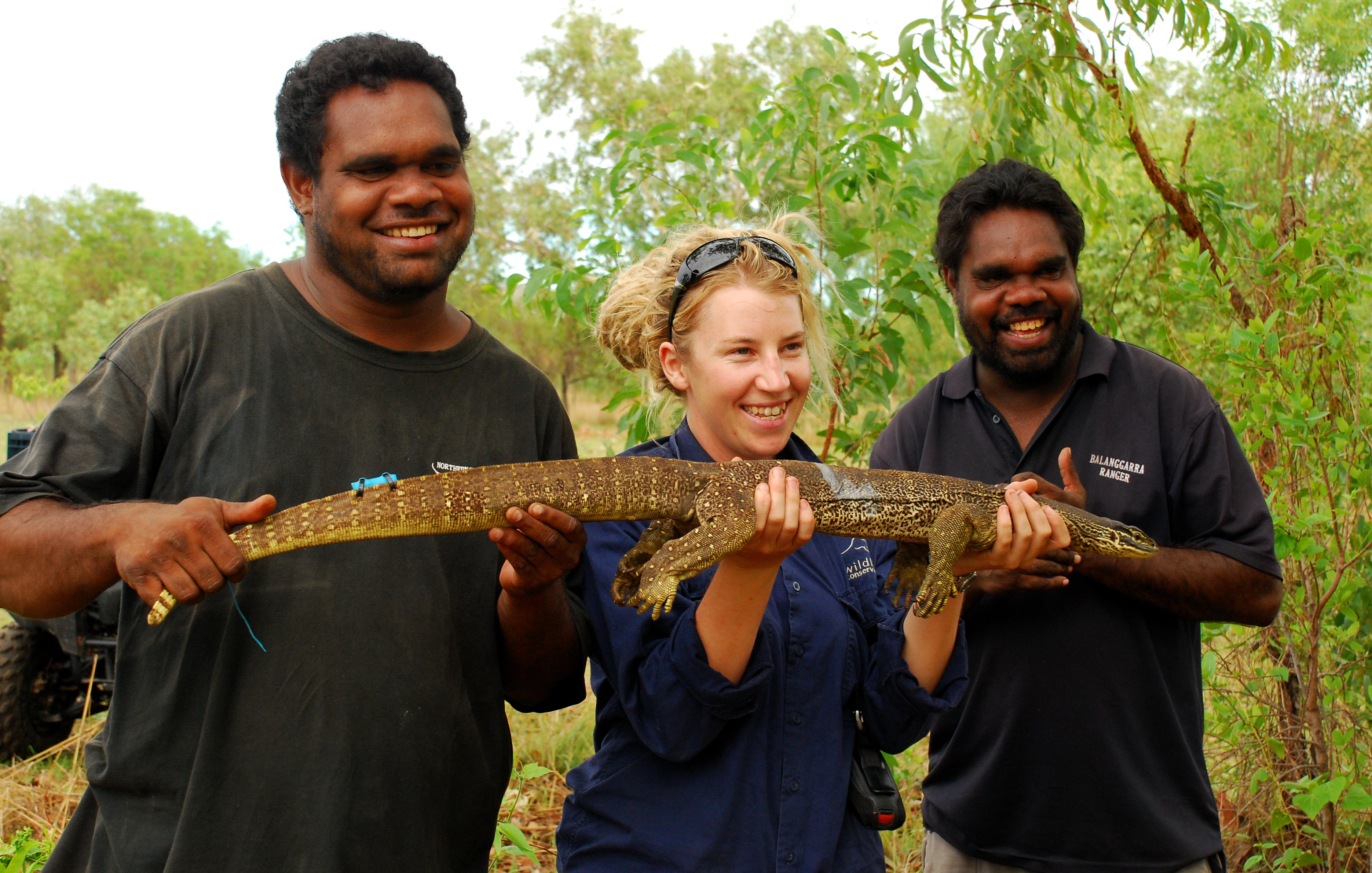
Georgia Ward-Fear worked closely with the Balanggarra Rangers (in this example, Herbert and Wesley Alberts) to test taste-aversion training for Yellow-spotted Goannas in the remote Kimberley. In this photo by Melissa Bruton, the team are about to release a radio-tracked goanna named "Barney".
The history of the “teacher toad”
concept is an interesting example of conservation in practice. Rick first had
the idea while he was preparing a talk to be given at the Australian Academy of
Science, who were giving him an award for his research. Journalists who attended his talk
ran the story in several media outlets,
ABC Science online article on teacher toad proposal.
The New Scientist magazine article about teacher toads.
Not surprisingly, the idea was controversial. Many people agree that we need to
“think outside the box” and to take advantage of TEAM BUFO’s newly-won
scientific understanding of toad biology to frame new ways to protect the
Australian environment. But some people aren’t so sure! Graeme Sawyer,
spokesperson of the Northern Territory’s Frogwatch group, called it a “crazy
idea” and “absolute folly” and indeed, suggested that it may reflect
extraterrestrial influence (“I don’t know what planet this guy’s off” – see the
story from the Northern Territory News below).
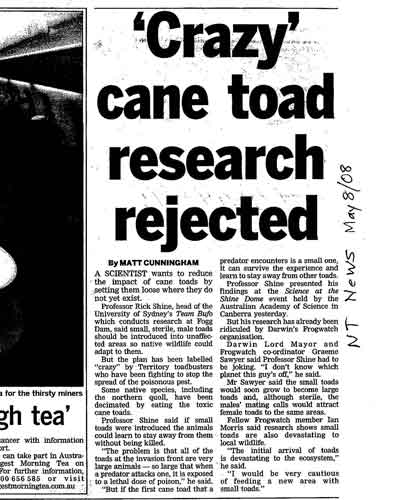
The idea of “teacher toads” was popular at the Australian Academy of Science, but Darwin’s Lord Mayor wasn’t impressed!
Much of the initial opposition to the “teacher toad” idea was a result of misunderstandings. And to be honest, we didn’t have any real evidence that it could work. But as the evidence accumulated from our field studies on quolls, bluetongue lizards and goannas, most of the sceptics were convinced. Rick and Georgia approached major organisations in the Kimberley to propose a landscape-scale implementation of the idea – and they agreed. The Australian Research Council funded the program. So from 2018 onwards, we and our partner organisations have been giving it a try. We are releasing tiny toads immediately in advance of the toad front – giving local predators an opportunity to learn about toads before the arrival of the main invasion front.
This is challenging work in remote, rough country –
but it’s possible. The progress of the toad invasion front has been mapped very
accurately over the last several years. Each year the toad invasion stalls
during the dry-season, when toads just find a damp spot and wait for the next
rainfall. As soon as the first rains arrive at the beginning of the wet-season
– often, after the first rains – the animals charge off to
recommence the invasion.
The front has progressed westwards from about 30 to 70 km each wet-season over
the last several years. If we know exactly where the front is at the end of the
wet (and that's possible only if groups like the Kimberley Toad-Busters are out
there to record that advance), we can identify a site - say, 5 km in front of
the current invasion frontline - where the toads will CERTAINLY arrive in the
following wet-season (and perhaps, within a week or two). We can drop small
toads in that site.
Many of those animals will be found by native predators, that will try to eat them. A few native predators MAY be killed – if the predator is very small or unusually sensitive to the toads’ poison – but most will survive. Although the small toads are toxic, they contain only a tiny fraction of the amount of poison in a big adult toad - much less than 1%.
Any ECOLOGICAL effect of these tiny “teacher toads” will be obliterated a few months later when the main toad invasion front passes through - the ecological impact of about 100 grams of tiny toads (that is, about 100 baby toads that each weigh one gram) is insignificant compared to the impact of about 1000 kilograms of adult toads (say, about 5,000 adult toads that each weigh 200 grams) moving through the same area a bit later!
However, those tiny toads can have a huge BEHAVIOURAL impact. Predators like goannas and quolls will locate the tiny toads. And many of the predators we have tested are really quick learners – once they have eaten a small toad and become ill as a result, they avoid all toads from then on. Any predator that has learnt to avoid toads is more likely to survive the actual toad invasion.
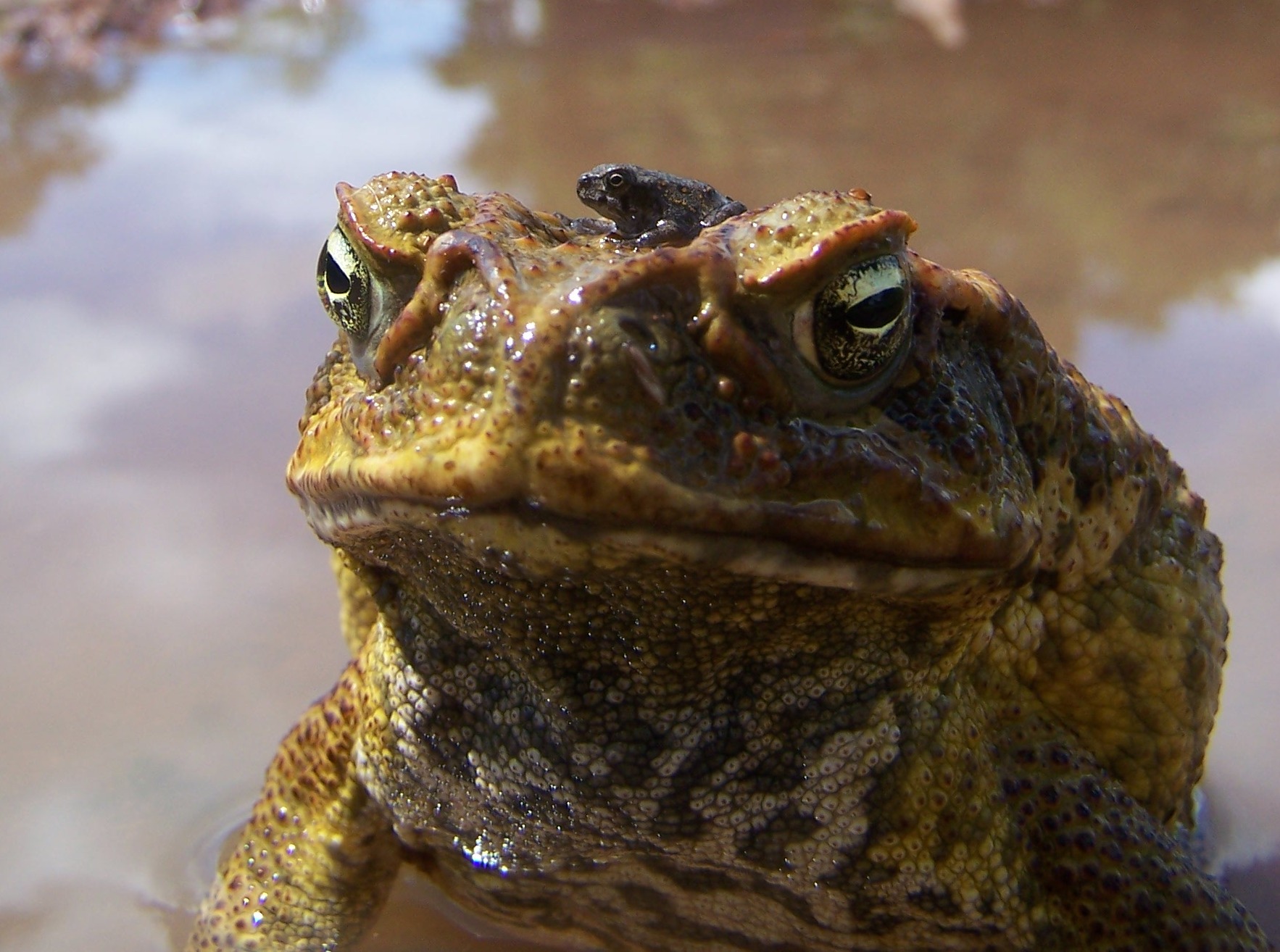
Cane toads come in a wide range of body sizes! They are very small when they first transform from the tadpole stage - as you can see from the tiny one we put on the head of this big toad, to show their relative sizes. Because they are so small, these little toads do not have enough poison to kill predators that try to eat them - but they can still cause severe nausea. So, tiny "teacher toads" released a few kilometres in advance of the toad invasion front can teach
native predators to avoid larger and more dangerous toads. Photo by Travis Child.
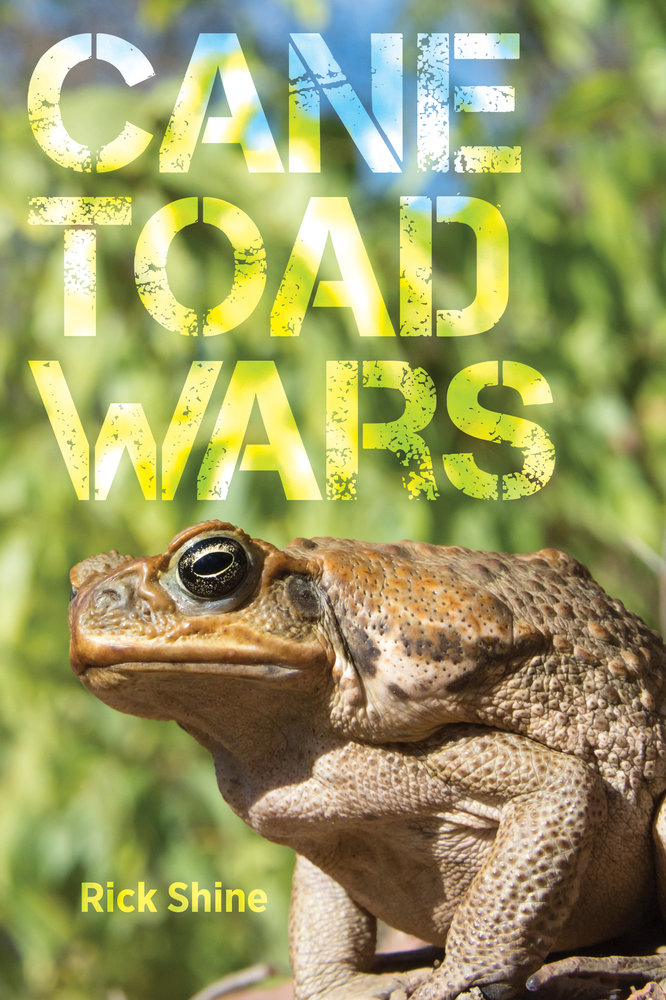
For the full story about the cane toad invasion of Australia, and what we can do about it, read Rick’s book “Cane Toad Wars” (published by University of California Press, 2018). The book is written for the general public, not for scientists, and is aimed at a wide audience. The book can be purchased through online bookstores like Amazon, or you can buy a copy through your local bookstore.
Return to Home Page
